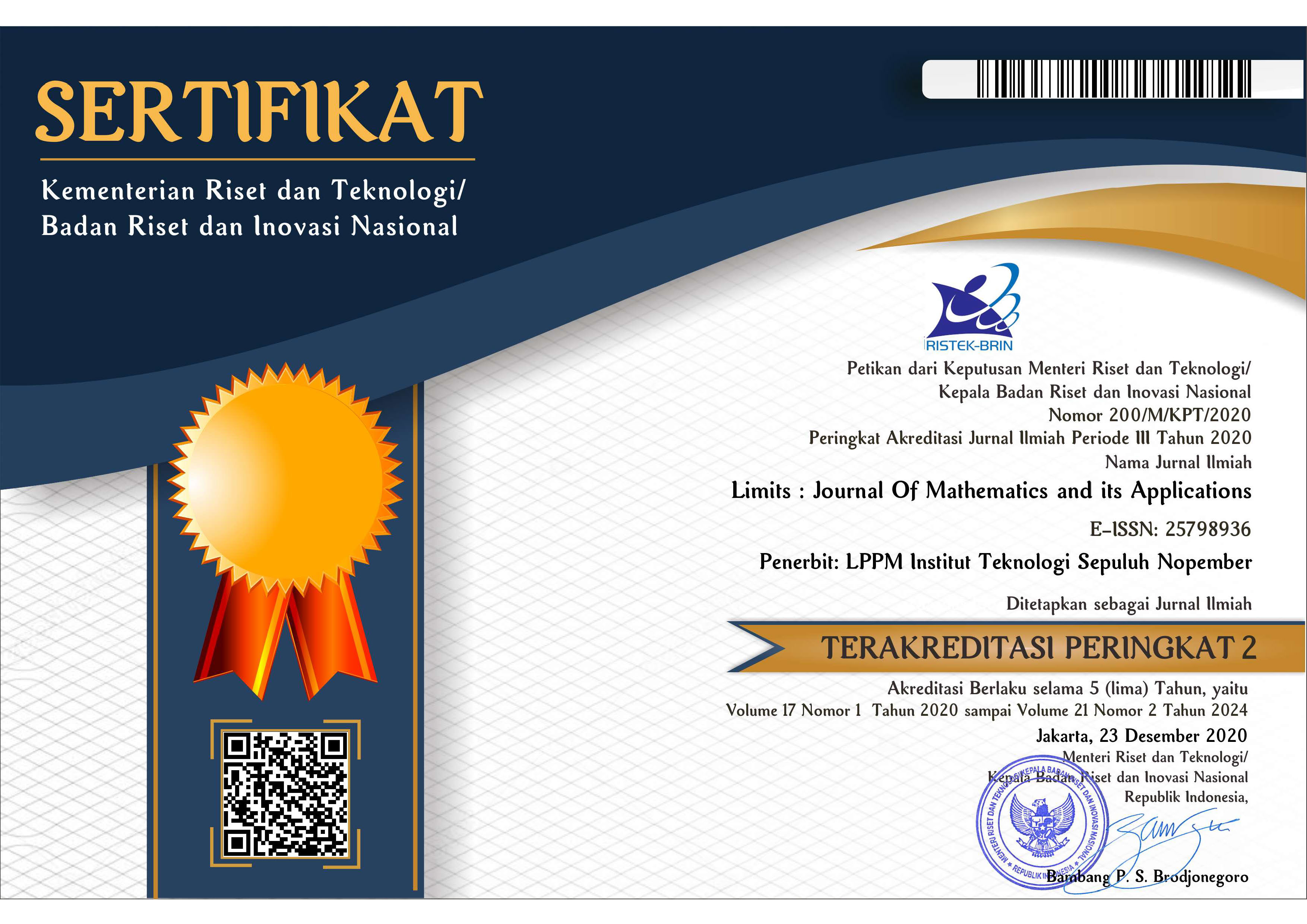Model Penyebaran Penyakit Filariasis dengan Intervensi Pengobatan Massal
Abstract
Keywords
Full Text:
PDFReferences
CDC, “Filariasis,” https://www.cdc.gov/parasites/lymphaticfilariasis/.
M. A. Stephano, M. M. Mayengo, J. I. Irunde, and D. Kuznetsov, “Sensitivity analysis and parameters estimation for the transmission of lymphatic filariasis,” Heliyon, vol. 9, no. 9, p. e20066, Sep. 2023, doi: 10.1016/j.heliyon.2023.e20066.
A. Chandy, A. S. Thakur, M. P. Singh, and A. Manigauha, “A review of neglected tropical diseases: filariasis,” Asian Pac J Trop Med, vol. 4, no. 7, pp. 581–586, Jul. 2011, doi: 10.1016/S1995-7645(11)60150-8.
R. P. Singh, L. De Britto, and G. Vijayalakshmi, “A study on ‘clinical epidemiology of filarial lymphedema patients attending filariasis clinic in Pondicherry,’” Clin Epidemiol Glob Health, vol. 8, no. 3, pp. 915–919, Sep. 2020, doi: 10.1016/j.cegh.2020.02.023.
P. Kulkarni, J. J. Thomas, J. Dowerah, M. R. Narayana Murthy, and K. Ravikumar, “Mass drug administration programme against lymphatic filariasis-an evaluation of coverage and compliance in a northern Karnataka district, India,” Clin Epidemiol Glob Health, vol. 8, no. 1, pp. 87–90, Mar. 2020, doi: 10.1016/j.cegh.2019.04.013.
WHO, “Filariasis,” https://www.cdc.gov/parasites/lymphaticfilariasis/.
A. Zerbo, R. Castro Delgado, and P. Arcos González, “Exploring the dynamic complexity of risk factors for vector-borne infections in sub-Saharan Africa: Case of urban lymphatic filariasis,” J Biosaf Biosecur, vol. 3, no. 1, pp. 17–21, Jun. 2021, doi: 10.1016/j.jobb.2021.03.002.
M. Laman et al., “Mass drug administration of ivermectin, diethylcarbamazine, plus albendazole compared with diethylcarbamazine plus albendazole for reduction of lymphatic filariasis endemicity in Papua New Guinea: a cluster-randomised trial.,” Lancet Infect Dis, vol. 22, no. 8, pp. 1200–1209, Aug. 2022, doi: 10.1016/S1473-3099(22)00026-3.
M. A. Irvine et al., “Effectiveness of a triple-drug regimen for global elimination of lymphatic filariasis: a modelling study,” Lancet Infect Dis, vol. 17, no. 4, pp. 451–458, Apr. 2017, doi: 10.1016/S1473-3099(16)30467-4.
C. P. Bhunu, “Assessing the potential of pre-exposure vaccination and chemoprophylaxis in the control of lymphatic filariasis,” Appl Math Comput, vol. 250, pp. 571–579, Jan. 2015, doi: 10.1016/j.amc.2014.11.018.
P. M. Mwamtobe, S. M. Simelane, S. Abelman, and J. M. Tchuenche, “Mathematical analysis of a lymphatic filariasis model with quarantine and treatment,” BMC Public Health, vol. 17, no. 1, p. 265, Dec. 2017, doi: 10.1186/s12889-017-4160-8.
F. A. Oguntolu, G. Bolarin, O. J. Peter, A. I. Enagi, and K. Oshinubi, “Mathematical model for the control of lymphatic filariasis transmission dynamics,” Communications in Mathematical Biology and Neuroscience, vol. 2021, 2021, doi: 10.28919/cmbn/5307.
P. K. N. Salonga, V. M. P. Mendoza, R. G. Mendoza, and V. Y. Belizario, “A mathematical model of the dynamics of lymphatic filariasis in Caraga Region, the Philippines,” R Soc Open Sci, vol. 8, no. 6, p. 201965, Jun. 2021, doi: 10.1098/rsos.201965.
O. Diekmann, J. A. P. Heesterbeek, and M. G. Roberts, “The construction of next-generation matrices for compartmental epidemic models,” J R Soc Interface, vol. 7, no. 47, pp. 873–885, Jun. 2010, doi: 10.1098/rsif.2009.0386.
M. Martcheva, An introduction to mathematical epidemiology, 1st ed. Springer, 2015.
DOI: http://dx.doi.org/10.12962%2Flimits.v20i3.16564
Refbacks
- There are currently no refbacks.
Jumlah Kunjungan:

Limits: Journal Mathematics and its Aplications by Pusat Publikasi Ilmiah LPPM Institut Teknologi Sepuluh Nopember is licensed under a Creative Commons Attribution-ShareAlike 4.0 International License.
Based on a work at https://iptek.its.ac.id/index.php/limits.






